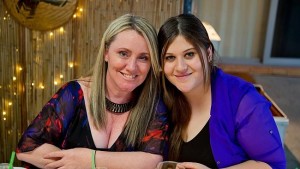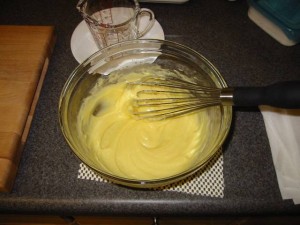Dean Ralph likes to hunt pheasant in Kansas. He likes to grill them as well.
After years of hearing me go on about tip-sensitive digital thermometers and their role in producing safe food, he finally got an automated contraption that hooks up to his BBQ.
The next time I saw him, he was gushing about how easier it was cooking with a thermometer and how he was a better cook for it (people tend to  overcook to compensate for pink meat).
overcook to compensate for pink meat).
Dean Ralph could teach the folks at My Kitchen Rules a few pointers – MKR for those in the know – another in a long line of terrible cooking shows offering terrible food safety advice (not you, Alton Brown), that airs Sunday nights in Australia.
I don’t watch. But apparently the folks at safefood Queensland do, and decided to be witty Monday morning by taking to the twittersphere to proclaim:
|
SFPQ
Last night’s team on #MKR learnt a great lesson while cooking their pheasant. Juices should run clear with no pink meat visible. #foodsafety
2/24/14, 9:45 AM |
Followed by:
|
|
SFPQ
When they saw blood after cooking for 15min, they wisely put it back in oven. Serving food poisoning is a good way to get a low score. #MKR
2/24/14, 9:46 AM |
So I twittered:
|
barfblog
Fail. Use a thermometer “@SFPQ: Last night’s team on #MKR cooking pheasant. Juices should run clear with no pink meat visible. #foodsafety”
2/24/14, 9:55 AM |
They wrote back:
SFPQ
Correct @barfblog if u have one. But a good guideline is no pink should be visible & juices run clear. If in doubt, cook it for longer.
2/24/14, 10:16 AM
To which I responded:
barfblog
Fail; color is a lousy indicator “@SFPQ: Correct @barfblog if u have one. But a good guideline is no pink visible & juices run clear.”
2/24/14, 10:47 AM
Several other food safety types jumped in to the twit-war, reinforcing that thermometers were indeed the best way to ensure microbiologically safe food. An hour later, safefood Queensland changed its tune.
|
SFPQ
Juices running clear & no visible pink is a starting point but use a #thermometer to make sure yr poultry & meats are cooked. #foodsafety
2/24/14, 11:48 AM |
And then:
|
SFPQ
Meat thermometers take the guess work out of #cooking. It’ll be the best thing you’ll invest in for yr health and safety. #foodsafety
2/24/14, 11:50 AM |
A five-minute search using Google yielded revealed that the U.S. Department of Agriculture recommends cooking pheasant to 165F (74C)  and letting the bird sit for 15 minutes. USDA states, “Cooked game meats can be pink even when the meat has reached a safe internal temperature.”
and letting the bird sit for 15 minutes. USDA states, “Cooked game meats can be pink even when the meat has reached a safe internal temperature.”
So can chicken and hamburger and pork. Color of the finished product is variable, primarily due to the age of the animal at harvest and other biochemical factors that are in a lot of references, readily available on barfblog.com, but safefoodQueensland can do the job itself.
The appropriately named BBQ Down Under recommends “a target temperature in the thickest part of the breast is 75°C (167°F) – check it using a thermometer probe. Put the probe in approximately 3/4 of the way into the breast meat, making sure you don’t go too far and hit bone.”
In Canada, the recommended temp is 82C (180F), but that’s another discussion. At least the U.S., and more recently Canada, can, on this issue, keep a straight face when they say they use science-based decision making.
safefood Queensland, you can do better, especially when your website has statements like:
“Raw chicken and poultry can carry bacteria, which is responsible for more cases of food poisoning than any other pathogen.”
Mathiasen, L.A., Chapman, B.J., Lacroix, B.J. and Powell, D.A. 2004. Spot the mistake: Television cooking shows as a source of food safety information, Food Protection Trends 24(5): 328-334.
Consumers receive information on food preparation from a variety of sources. Numerous studies conducted over the past six years demonstrate that television is one of the primary sources for North Americans. This  research reports on an examination and categorization of messages that television food and cooking programs provide to viewers about preparing food safely. During June 2002 and 2003, television food and cooking programs were recorded and reviewed, using a defined list of food safety practices based on criteria established by Food Safety Network researchers. Most surveyed programs were shown on Food Network Canada, a specialty cable channel. On average, 30 percent of the programs viewed were produced in Canada, with the remainder produced in the United States or United Kingdom. Sixty hours of content analysis revealed that the programs contained a total of 916 poor food-handling incidents. When negative food handling behaviors were compared to positive food handling behaviors, it was found that for each positive food handling behavior observed, 13 negative behaviors were observed. Common food safety errors included a lack of hand washing, cross-contamination and time-temperature violations. While television food and cooking programs are an entertainment source, there is an opportunity to improve their content so as to promote safe food handling.
research reports on an examination and categorization of messages that television food and cooking programs provide to viewers about preparing food safely. During June 2002 and 2003, television food and cooking programs were recorded and reviewed, using a defined list of food safety practices based on criteria established by Food Safety Network researchers. Most surveyed programs were shown on Food Network Canada, a specialty cable channel. On average, 30 percent of the programs viewed were produced in Canada, with the remainder produced in the United States or United Kingdom. Sixty hours of content analysis revealed that the programs contained a total of 916 poor food-handling incidents. When negative food handling behaviors were compared to positive food handling behaviors, it was found that for each positive food handling behavior observed, 13 negative behaviors were observed. Common food safety errors included a lack of hand washing, cross-contamination and time-temperature violations. While television food and cooking programs are an entertainment source, there is an opportunity to improve their content so as to promote safe food handling.
 Producers were quick to clarify Kaponias did not get ill during filming of Channel 7’s top-rating series, but was admitted to hospital after eating out during a production break.
Producers were quick to clarify Kaponias did not get ill during filming of Channel 7’s top-rating series, but was admitted to hospital after eating out during a production break.




